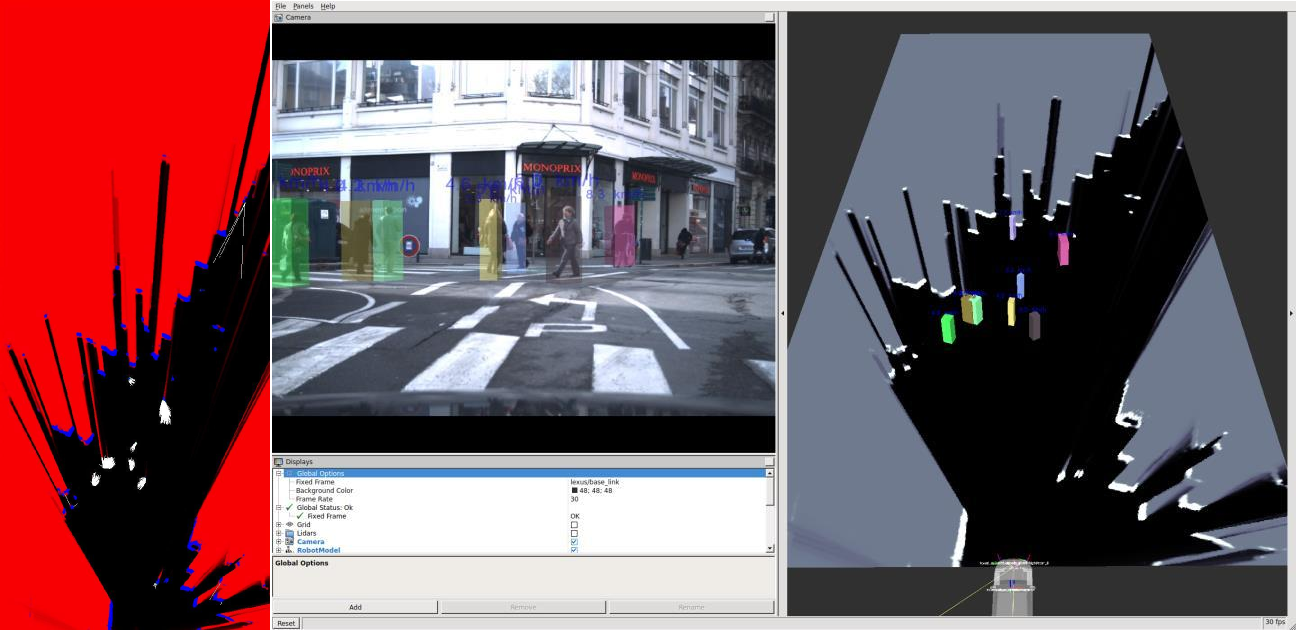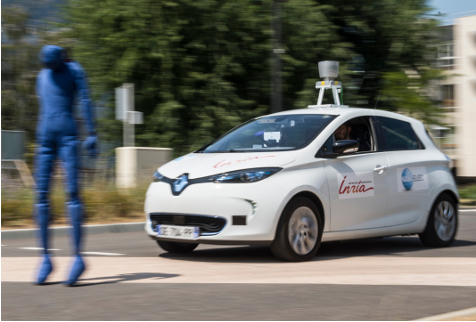Section: Research Program
Perception and Situation Awareness
Participants : Christian Laugier, Agostino Martinelli, Jilles S. Dibangoye, Anne Spalanzani, Olivier Simonin, Christian Wolf, Ozgur Erkent, Alessandro Renzaglia, Rabbia Asghar, Jean-Alix David, Thomas Genevois, Jerome Lussereau, Anshul Paigwar, Lukas Rummelhard.
Robust perception in open and dynamic environments populated by human beings is an open and challenging scientific problem. Traditional perception techniques do not provide an adequate solution for these problems, mainly because such environments are uncontrolled (partially unknown and open) and exhibit strong constraints to be satisfied (in particular high dynamicity and uncertainty). This means that the proposed solutions have to simultaneously take into account characteristics such as real time processing, temporary occultations, dynamic changes or motion predictions.
Bayesian perception
Context. Perception is known to be one of the main bottlenecks for robot motion autonomy, in particular when navigating in open and dynamic environments is subject to strong real-time and uncertainty constraints. In order to overcome this difficulty, we have proposed in the scope of the former e-Motion team, a new paradigm in robotics called “Bayesian Perception”. The foundation of this approach relies on the concept of “Bayesian Occupancy Filter (BOF)” initially proposed in the Ph.D. thesis of Christophe Coue [55] and further developed in the team (The Bayesian programming formalism developed in e-Motion, pioneered (together with the contemporary work of Thrun, Burgard and Fox [91]) a systematic effort to formalize robotics problems under Probability theory–an approach that is now pervasive in Robotics.). The basic idea is to combine a Bayesian filter with a probabilistic grid representation of both the space and the motions. It allows the filtering and the fusion of heterogeneous and uncertain sensors data, by taking into account the history of the sensors measurements, a probabilistic model of the sensors and of the uncertainty, and a dynamic model of the observed objects motions.
In the scope of the Chroma team and of several academic and industrial projects (in particular the IRT Security for autonomous vehicle and Toyota projects), we went on with the development and the extension under strong embedded implementation constraints, of our Bayesian Perception concept. This work has already led to the development of more powerful models and more efficient implementations, e.g. the CMCDOT (Conditional Monte Carlo Dense Occupancy Tracker) framework [83] which is still under development.
This work is currently mainly performed in the scope of the “Security for Autonomous Vehicle (SAV)” project (IRT Nanoelec), and more recently in cooperation with some Industrial Companies (see section New Results for more details on the non confidential industrial cooperation projects).
Objectives. We aim at defining a complete framework extending the Bayesian Perception paradigm to the object level. The main objective is to be simultaneously more robust, more efficient for embedded implementations, and more informative for the subsequent scene interpretation step (Figure 2.a illustrates). Another objective is to improve the efficiency of the approach (by exploiting the highly parallel characteristic of our approach), while drastically reducing important factors such as the required memory size, the size of the hardware component, its price and the required energy consumption. This work is absolutely necessary for studying embedded solutions for the future generation of mobile robots and autonomous vehicles. We also aim at developing strong partnerships with non-academic partners in order to adapt and move the technology closer to the market.
|
System validation
Context. Testing and validating Cyber Physical Systems which are designed for operating in various real world conditions, is both an open scientific question and a necessity for a future deployment of such systems. In particular, this is the case for Embedded Perception and Decision-making Systems which are designed for future ADAS (Advance Driving Assistance System) and Autonomous Vehicles. Indeed, it is unrealistic to try to be exhaustive by making a huge number of experiments in various real situations. Moreover, such experiments might be dangerous, highly time consuming, and expensive. This is why we have decided to develop appropriate realistic simulation and statistical analysis tools for being able to perform a huge number of tests based on some previously recorded real data and on random changes of some selected parameters (the “co-simulation” concept). Such an approach might also be used in a training step of a machine learning process. This is why simulation-based validation is getting more and more popular in automotive industry and research.
This work is performed in the scope of both the SAV (Security for Autonomous Vehicles) project (IRT Nanoelec) and of the EU Enable-S3 project; it is also performed in cooperation with the Inria team Tamis in Rennes, with the objective to integrate the Tamis “Statistical Model Checking” (SMC) approach into our validation process. We are also starting to work on this topic with the Inria team Convecs, with the objective to also integrate formal methods into our validation process.
Objectives. We started to work on this new research topic in 2017. The first objective is to build a “simulated navigation framework” for: (1) constructing realistic testing environments (including the possibility of using real experiments records), (2) developing for each vehicle a simulation model including various physical and dynamic characteristics (e.g. physics, sensors and motion control), and (3) evaluating the performances of a simulation run using appropriate statistical software tools.
The second objective is to develop models and tools for automating the Simulation & Validation process, by using a selection of relevant randomized parameters for generating large database of tests and statistical results. Then, a metric based on the use of some carefully selected “Key Performance Indicator” (KPI) has to be defined for performing a statistical evaluation of the results (e.g. by using the above-mentioned SMC approach).
Situation Awareness and Prediction
Context. Predicting the evolution of the perceived moving agents in a dynamic and uncertain environment is mandatory for being able to safely navigate in such an environment. We have recently shown that an interesting property of the Bayesian Perception approach is to generate short-term conservative (i.e. when motion parameters are supposed to be stable during a small amount of time) predictions on the likely future evolution of the observed scene, even if the sensing information is temporary incomplete or not available [79]. But in human populated environments, estimating more abstract properties (e.g. object classes, affordances, agent’s intentions) is also crucial to understand the future evolution of the scene. This work is carried out in the scope of the Security of Autonomous Vehicle (SAV) project (IRT Nanoelec) and of several cooperative and PhD projects with Toyota and with Renault.
Objectives. The first objective is to develop an integrated approach for “Situation Awareness & Risk Assessment” in complex dynamic scenes involving multiples moving agents (e.g vehicles, cyclists, pedestrians ...), whose behaviors are most of the time unknown but predictable. Our approach relies on combining machine learning to build a model of the agent behaviors and generic motion prediction techniques (e.g. Kalman-based, GHMM , or Gaussian Processes). In the perspective of a long-term prediction we will consider the semantic level (knowledge about agent’s activities and tasks) combined with planning techniques.
The second objective is to build a general framework for perception and decision-making in multi-robot/vehicle environments. The navigation will be performed under both dynamic and uncertainty constraints, with contextual information and a continuous analysis of the evolution of the probabilistic collision risk. Interesting published and patented results [67] have already been obtained in cooperation with Renault and UC Berkeley, by using the “Intention / Expectation” paradigm and Dynamic Bayesian Networks. We are currently working on the generalization of this approach, in order to take into account the dynamics of the vehicles and multiple traffic participants. The objective is to design a new framework, allowing us to overcome the shortcomings of rules-based reasoning approaches which often show good results in low complexity situations, but which lead to a lack of scalability and of long terms predictions capabilities.
Robust state estimation (Sensor fusion)
Context. In order to safely and autonomously navigate in an unknown environment, a mobile robot is required to estimate in real time several physical quantities (e.g., position, orientation, speed). These physical quantities are often included in a common state vector and their simultaneous estimation is usually achieved by fusing the information coming from several sensors (e.g., camera, laser range finder, inertial sensors). The problem of fusing the information coming from different sensors is known as the Sensor Fusion problem and it is a fundamental problem which plays a major role in robotics.
Objective. A fundamental issue to be investigated in any sensor fusion problem is to understand whether the state is observable or not. Roughly speaking, we need to understand if the information contained in the measurements provided by all the sensors allows us to carry out the estimation of the state. If the state is not observable, we need to detect a new observable state. This is a fundamental step in order to properly define the state to be estimated. To achieve this goal, we apply standard analytic tools developed in control theory together with some new theoretical concepts we introduced in [71] (concept of continuous symmetry). Additionally, we want to account the presence of disturbances in the observability analysis.
Our approach is to introduce general analytic tools able to derive the observability properties in the nonlinear case when some of the system inputs are unknown (and act as disturbances). We recently obtained a simple analytic tool able to account the presence of unknown inputs [73], which extends a heuristic solution derived by the team of Prof. Antonio Bicchi [51] with whom we collaborate (Centro Piaggio at the University of Pisa).
Fusing visual and inertial data. A special attention is devoted to the fusion of inertial and monocular vision sensors (which have strong application for instance in UAV navigation). The problem of fusing visual and inertial data has been extensively investigated in the past. However, most of the proposed methods require a state initialization. Because of the system nonlinearities, lack of precise initialization can irreparably damage the entire estimation process. In literature, this initialization is often guessed or assumed to be known [49], [69], [61]. Recently, this sensor fusion problem has been successfully addressed by enforcing observability constraints [63], [64] and by using optimization-based approaches [68], [60], [70], [65], [78]. These optimization methods outperform filter-based algorithms in terms of accuracy due to their capability of relinearizing past states. On the other hand, the optimization process can be affected by the presence of local minima. We are therefore interested in a deterministic solution that analytically expresses the state in terms of the measurements provided by the sensors during a short time-interval.
For some years we explore deterministic solutions as presented in [72] and [74]. Our objective is to improve the approach by taking into account the biases that affect low-cost inertial sensors (both gyroscopes and accelerometers) and to exploit the power of this solution for real applications. This work is currently supported by the ANR project VIMAD (Navigation autonome des drones aériens avec la fusion des données visuelles et inertielles, lead by A. Martinelli, Chroma.) and experimented with a quadrotor UAV. We have a collaboration with Prof. Stergios Roumeliotis (the leader of the MARS lab at the University of Minnesota) and with Prof. Anastasios Mourikis from the University of California Riverside. Regarding the usage of our solution for real applications we have a collaboration with Prof. Davide Scaramuzza (the leader of the Robotics and Perception group at the University of Zurich) and with Prof. Roland Siegwart from the ETHZ.




